Examples of writing
Gallo-greek : Inscription on stone (Vaison-la-Romaine)
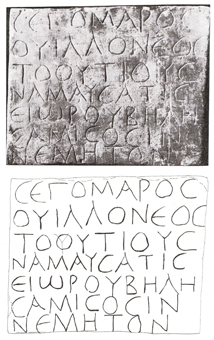
Source: RIG I, G-153 (RIIG VAU-13-01)
This block, preserved in the Calvet lapidary museum in Avignon, is very legibly inscribed in Gallo-Greek script:
σεγομαρος
ουιλλονεος
τοουτιουϲ
ναμαυσατις
ειωρου βηλη-
σαμι σοσιν
νεμητον
"Segomaros, son of Villū, citizen of Nîmes, offered this sacred enclosure to Belesama " (translation P.-Y. Lambert).
This is a votive dedication confirmed by the presence of the Gaulish verb ειωρου, one of the few known Gaulish verbs that only appears in dedications. This offering is addressed to Belesama (in the dative), the Gaulish Minerva. Quite unusually, the dedicator has indicated his geographical and 'political' origin: Nîmes (ναμαυσατις is an ethnic in -ati derived from Nemausus, the Celtic name of Nîmes). τοουτιουϲ appears to be derived from a Celtic term touta 'tribe, clan', here translated as 'citizen'. The object of the dedication is a nemeton (νεμητον) which seems to be a sacred wood or enclosure (sosin/σοσιν is a demonstrative). The person who offers this nemeton (νεμητον) is mentioned in the first two lines. He is Segomaros (compound name from sego- = 'victory, strength' and -maros = 'great') who is identified in the Gaulish way, mentioning his father's name with a suffix (villu(n)-eos).
Gallo-greek : Inscription on stone (Nîmes)

Source: RIG I, G-203 (RIIG GAR-10-01)
Doric capital dedicated to the Mothers of Nîmes, discovered in 1740 and kept in the Musée de la Romanité in Nîmes.
[.]αρταρ/ος ι/λλανουιακος δεδε
ματρεβο ναμαυσικαβο βρατουδε[
" (?)artaros son of Illanus (offered it) to the Mothers of Nîmes, (?) in gratitude, with the tithe/for the fulfilment of the vow" (translation: P.-Y. Lambert).
This is a pedestal bearing an inscription which accompanied a statue offered (now disappeared).
The writing is regular and neat and it is one of the Gallo-Greek inscriptions that can be described as the most elegant. It provides a complete dedication formula consisting of a verb in the perfect tense δεδε (root: *di, 'to offer, to give') followed by a term that is still debated and can be completed on the basis of other occurrences: βρατουδε[καντεμ (bratou-dekantem).
The name of the dedicator is damaged (Martaros?) but he is identified in Gaulish with the mention of his father's name followed by a suffix: Illanu(s) + iako(s). The whole (statue + inscription) is offered to deities mentioned in the plural dative (in -bo): ματρεβο ναμαυσικαβο, the Nîmes Mothers, ναμαυσικαβο is an epiclesis derived in -iko- on the Gaulish name of Nîmes.
Gallo-latin : Inscription on stone (Alise-Sainte-Reine)
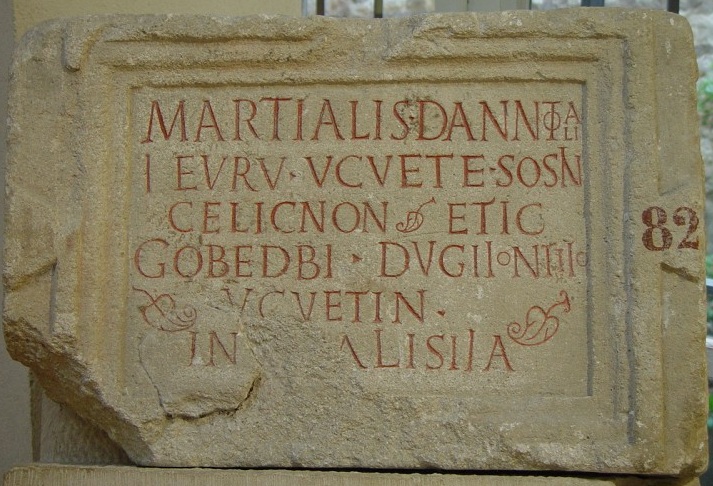
Source: RIG II 1 L-13 (RIIG CDO-01-19)
This monumental inscription is one of the rare stone inscriptions of Gallo-Latin epigraphy. The block of stone (49 x 74 x 13 cm), found in 1839 on Mount Auxois, is preserved in the MuseoParc of Alise-Sainte-Reine.
MARTIALIS • DANNOTALI
IEVRV • VCVETE • SOSIN
CELICNON ETIC
GEBEDBI . DUGIIONTIIO
VCVETIN
IN ALISIIA
"Martialis, Dannotalos'son, offered this building to Ucuetis, and this in accordance with the blacksmiths who honour Ucuetis in Alesia" (translation: P.-Y. Lambert).
After the dedicant's name, there is the same verb as on the Roman inscription from Vaison-la-Romaine IEVRV, this time using the Latin alphabet.
The theonym is in the dative VCVETE (theme in *i. According to P.-Y. Lambert, it is a noun of an agent in -ti, on a denominative of the theme *okuo- 'sharp, sharpened' (cf. Latin: acuus) 'the sharpener', which corresponds well to the lexical field of blacksmiths.
The object offered, the CELICNON (here in the accusative, preceded by a demonstrative SOSIN also present in Vaison-la-Romaine) is probably a place of worship. Such a building was excavated in Alise-Sainte-Reine, at the beginning of the 20th century, shortly after the discovery of this stone. It is a two-storey building (probably a shop and a meeting room). This place of worship received metal offerings, which corroborates the presence of blacksmiths in the inscription.
A second part of the inscription was introduced by ETIC (eti cf. Latin et, Greek ἔτι and the enclitic particle -kwe with apocope).
gobedbi, the term for blacksmith, is in the instrumental case, in the plural form in - bi. dugiIontiIo would be a verbal form in the 3rd person plural, whose stem is not yet clearly identified.
Lastly, the locative AlisiIa made this inscription famous because it was the first reference found to the well-known city of Alesia, place of Vercergetorix's final battle and the final conflict of the Gaulish Wars.
Gallo-Latin: magical inscription on lead-plaque (L'Hospitalet-du-Larzac)
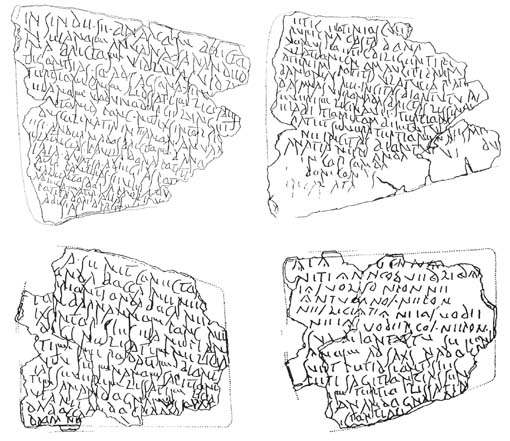
Source: P.-Y. Lambert, La langue gauloise, 1994 (2018
3), p. 162-165.
This lead-plaque (RIG II.2, L-98) is the longest document in Gaulish known so far. Discovered in 1983, it is one of a group of "magical" documents containing defixiones; these curse tablets were very common in the Gaulish magical tradition.
The document is composed of two tablets found one upon another, on the top of a funeral urn. It contains around 60 lines and 170 words (or fragmentary words).
It was written by two distinct hands. The first text apparently re-enacted a witch battle. The second use of the tablet seemed to have sought to lessen the magic of the former; the second hand also seems to have been less Latinized than the first one.
P.-Y. Lambert's translation:
1a, 1-7: “Send this women's charm against the names here below; this (is) a witch charm bewitching witches. O Adsagsona, look twice Severa Tertionicna, their thread (that which ties?) witch and their writing (that which writes?) witch, let it release the one whom they will have struck with a curse; with a bad spell against their names, make the bewitchment against this group [+ a dozen feminine names].”
1b, 6-7: “let these women mentioned here above, once bewitched, be powerless in front of him.”
2a, 3-10: “Any man acting as a judge, that these women would have struck with a curse, let her (Severa Tertionicna) delete this man's curse; let there not be any witch by writing, witch by thread, witch by giving among these women, who solicit Servera witch by writing, witch by thread, the foreigner.”
Gallo-Latin: Calendar from Coligny (Ain)
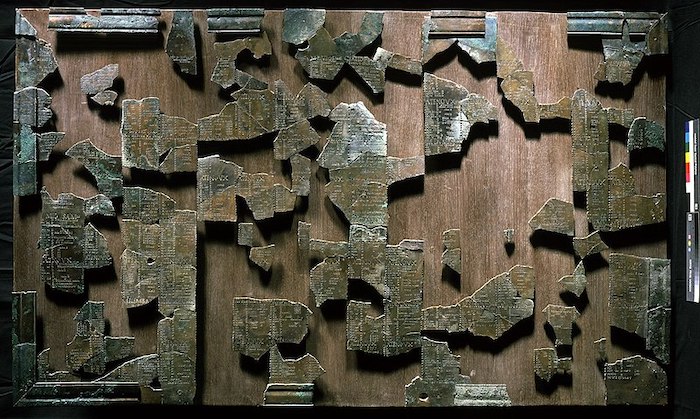
Source: Wikimedia Commons
This bronze plaque is conserved in the Gallo-Roman Museum in Lyon-Fourvière. It was found in 1897 in Ain.
It is a Gaulish calendar written using the Latin alphabet in the 2nd c. AD. This exemplar is most probably a late copy of an older calendar.
It counts five consecutive years. Months are lunar and months of 30 days (MAT "good") alternate with months of 29 days (ANMAT "bad"). The lunar calendar is spread over the solar year, which is why this calendar has leap months (one at the beginning of the first year and one in the middle of the third year).
Written in 16 columns, it has 4 months per column. There are no phrases (perhaps only one in the heading of the first leap month).
The names of the months can be read as follows (with many graphic variants):
I-SAMON
II-DVMAN
III-RIVROS
IV-ANAGAN
V-OGRONN
VI-CVT-
VII-GIAMON
VIII-SIMIVIS
IX-EQVOS
X-ELEMBIV
XI-AEDRINI
X-CANTLOS
Gallo-Latin: Potter's accounts (La Graufesenque)
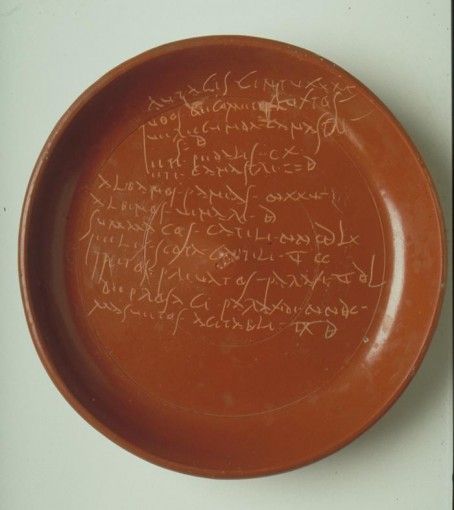
Source: RIG II.2, L-20 Musée Fenaille
The archaeological site of La Graufesenque (Millau, Aveyron, France) is exceptional for Gaulish epigraphy. At the beginning of the 20th century, thousands of terra sigillata ceramic shards coming from potters' kilns were found.
For economic reasons, kilns were shared between many potters, who could in this way bake their products together. An “accounts list” was also put into the kiln during baking; this list, which recapitulated the distinct lots placed in the kiln, was a simple clay plate baked with the rest of the batch.
These documents are precious for us. They provide numerous anthroponymic elements as well as figures on the operation of the workshops.
On the other hand, there are no long sentences, and the common names that can be read in them are very technical, relating to accounting and pottery technology.
Gallo-Etruscan : bilingual Inscription from Vercelli
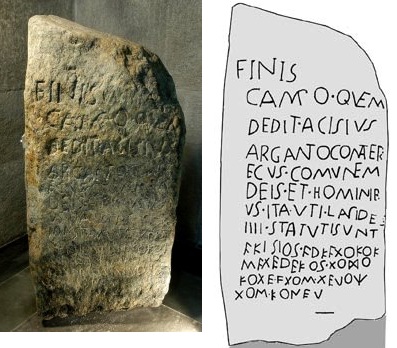
Source: RIG II 1, E-2. Musée Camillo Leone (Vercelli)
This bilingual inscription from the 2nd c. BC is written on a schist stone, discovered in 1960 in Piedmont (height: 149 cm; width: 70 cm).
It is a boundary stone which delimitated, with three other stones now lost, the land of a man named Acisius "Argantomaterecus".
One text is written in Latin, using the Latin alphabet and a second one is written in Gaulish, using the Gallo-Etruscan alphabet.
The Latin text is as follows:
Finis / campo . quem / dedit . Acisius / argantomater / ecus . communem / deis . et . hominib / us . ita . uti . lapides / II II . statuti sunt
Translation: P.-Y. Lambert: "End of the land that Acisius Arganto-materecus gave to be in common amongst gods and men, within the area where the four stones were erected."
Gaulish text is as follows:
aKisios. arKaToKo{K} / maTereKos . To[ś]o / KoT[e (.) a]Tom/ś Teuoχ / Toni[o]n EV
Translation: P.-Y. Lambert: "Acisios Argantomaterekos (gave) the ATOS that belongs to gods and men."
The owner's name (in nominative, Akisios) is followed by a disputed term, with multiple components. P.-Y. Lambert proposes the following construction: preposition kom- “with” + ater-, “father” + suffix -eko-. This syntagm -atereko- would be equivalent to the Latin patricius “patrician”, according to P.-Y. Lambert. Following the same idea, the sequence komatereko- should be compared to the expression “patres conscripti”. Arganto-komatereko would then indicate the fee requested by the treasurer (the Roman Quaestor).
The Latin text is more specific and seems more detailed than the Gaulish one.
The word ATOŠ or ATOM from the Gaulish text cannot be translated. It is commented in the Latin version of the text by the word campus. What seems to be the verbal form in the Gaulish sentence, TO[.]O / KOT[..] could be read TOŠOKOTE , the preterit of the verb "to give", perhaps with an infix -so-.
The adjective TEUOXTONION, “common to gods and men” is a compound form which M. Lejeune analysed as "divine" (*deiwo- ) and “terrestrial, mortal” (*gdhon-io-).
The last two letters could be the abbreviation for EX VOTO: in this area Romanization was already very advanced, as the necessity of a bilingual inscription indicates.
Gallo-Etruscan: bilingual Inscription from Briona
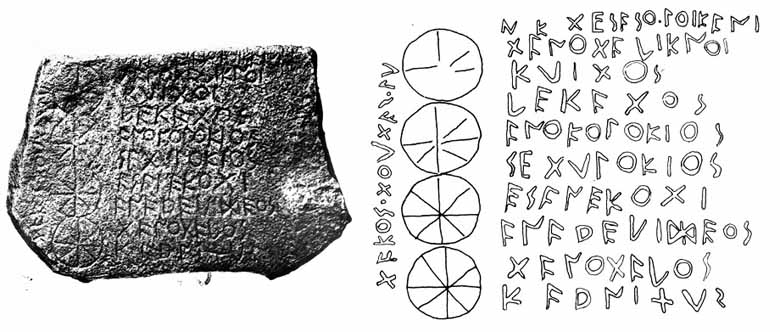
Source: RIG II 1, E-1.
This irregular stone (140 x 95 cm) was found in 1859 10 km northeast of Briona. The inscription can be dated to the 2nd-1st c. BC.
It features four wheels drawn vertically. The principal text (9 lines) contains almost exclusively personal names. A secondary text (a) is carved on the superior part of the stone, in the same direction as the principal text.
Lastly, a second text (b) can be read vertically, near the wheels. The order of reading is controversial.
a) ]n[.]k[..]esasoioikan[
tanotaliknoi
kuitos
lekatos
anokopokios
setupokios
esanekoti
anareuišeos
tanotalos
karnitus
b) takos·toutas·[
" a) ?" "Dannotalos'sons, Quintos, legate, Andocombogios, Setubogios, and Essandecot(t)os'(sons), Andareuiseos, Dannotalos, have raised this cairn" "b) ? decision of the tribe" (translation: P.-Y. Lambert).
TANOTALIKNOI (which cannot be separated from TANOTALOS) shows a patronymic suffixation -ikno-. It is followed by three names in the nominative: KUITOS = Quintos, borrowing from Latin, as well as the attributive adjective in Latin LEKATOS = legatus.
The anthroponyms ANOKOPOKIOS and SETUPOKIOS, are Celtic composed names in -bogios = "who strikes".
A second section is composed of ESANEKOTI (sons), in the genitive case: they are ANNAREUISEOS and TANOTALOS.
The final verb KARNITUS , derived from *karno "cairn", is the only indication for the function of the inscription, which is the dedication of a cairn.
The (b) text is also disputed. Two noteworthy terms are TAKOS (perhaps meaning "order, decision", in parallel with Old Welsh and Oscan) and the word TOUTAS , which is the name for a Gaulish political unit.
For a recent article and a new reading of this inscription see Estarán 2015.